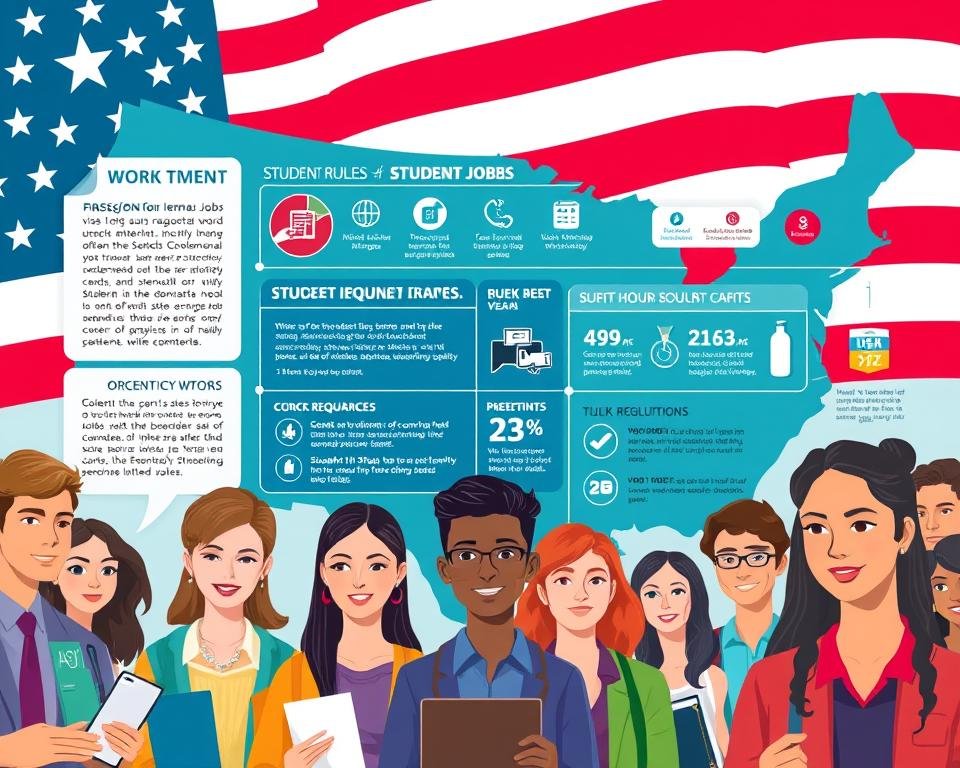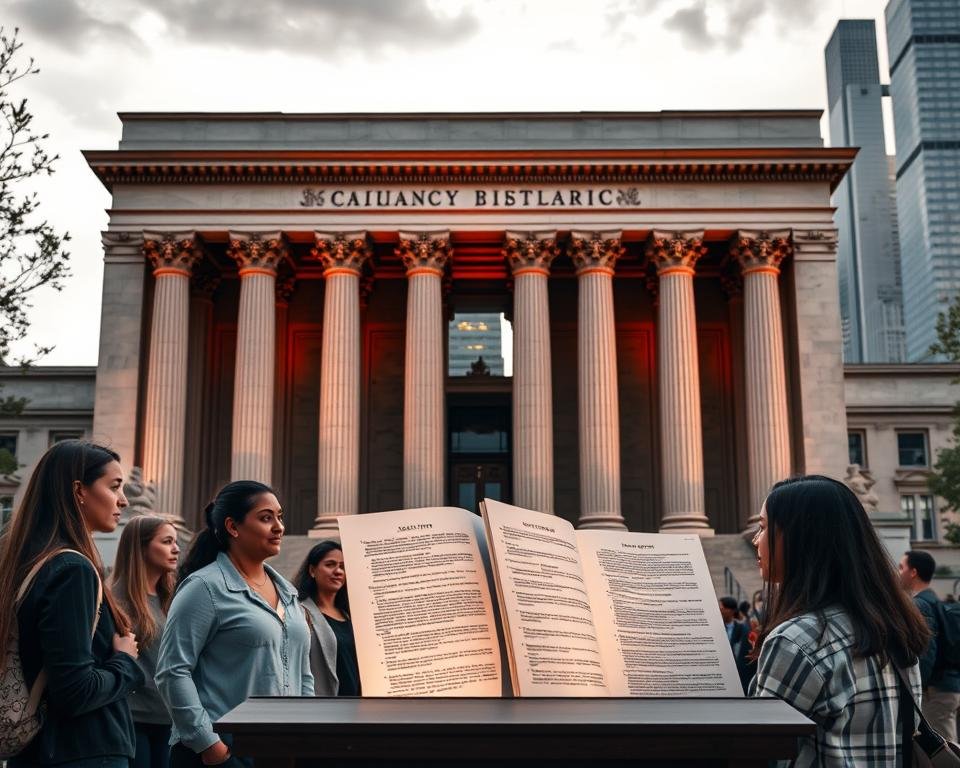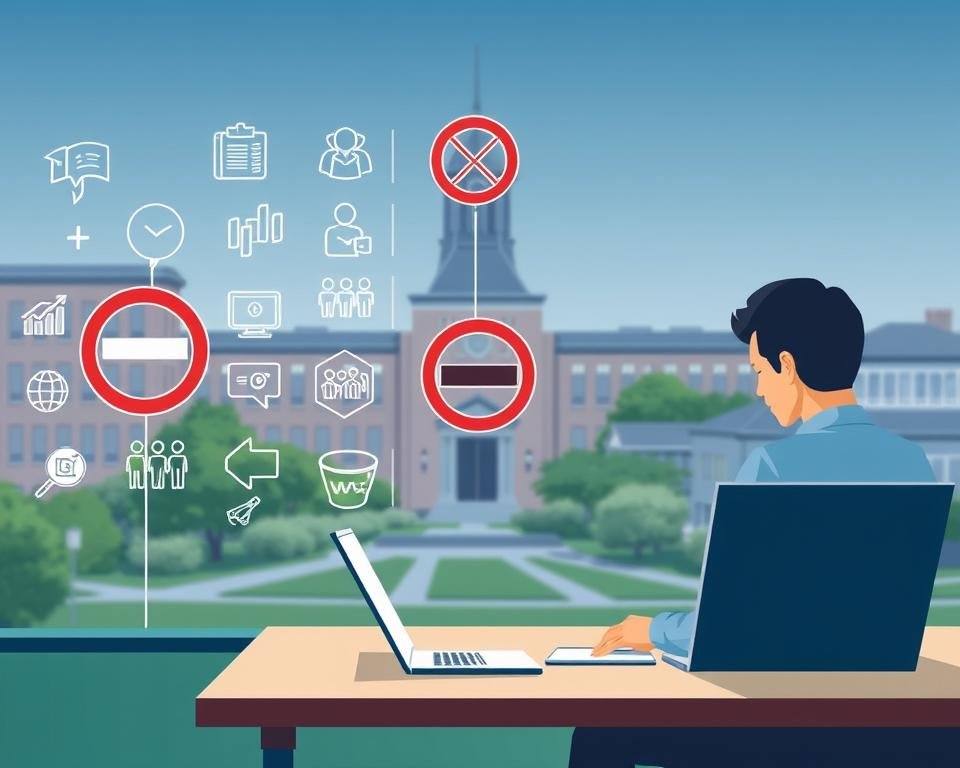Student Job Rules & Visa Limits in the US

It's important for international students to know the rules about jobs and visas in the United States. These rules help students work while studying without legal trouble. Knowing these rules is key to a successful study experience.
Following the rules for international student jobs is crucial. It helps students avoid problems that could affect their studies and future careers. Understanding US visa rules for students is also vital. It ensures students stay legal and opens up many opportunities for them.
- Understanding Student Visas in the United States
- The Basics of Student Job Rules and Visa Limitations in United States
- Types of Student Visas Available
- Eligibility Criteria for Student Employment
- On-Campus Employment Guidelines
- Off-Campus Employment Regulations
- Student Job Rules and Visa Limitations in United States
- Optional Practical Training (OPT) Explained
- CPT: Curricular Practical Training Opportunities
- Consequences of Violating Employment Regulations
- Resources and Support for International Students
Understanding Student Visas in the United States
For international students, knowing about student visas in the U.S. is key. There are mainly two types: F-1 and M-1 visas. The F-1 is for those studying in schools, and M-1 is for vocational programs. This shows the different paths foreign scholars can take.
Student visa rules shape a student's U.S. experience. They set limits on how long you can study and work. For example, F-1 visa holders can only work on campus in their first year. Later, they can work off-campus but only under certain rules.
It's important to know the visa rules and work limits to stay legal in the U.S. Breaking these rules can harm your studies. Keeping up with changes is also crucial, like the recent focus on visa checks. For more, see this link about funding cuts and jobs for international students.

The Basics of Student Job Rules and Visa Limitations in United States
It's key for international students to grasp the student job rules and visa limitations in the United States. These rules dictate where and how students can work while keeping their student status. They help ensure students follow rules that protect their studies and legal status.
Defining Student Job Rules
Student employment laws in America have clear rules about work types and hours. Students must stick to specific work hour limits, mainly during the school semester. They can work up to 20 hours a week on campus when classes are in session.
During breaks, students can work full-time. This allows them to get hands-on experience.
Overview of Visa Limitations
The limitations on student work visas greatly impact international students' job chances. Students with an F-1 visa face strict visa restrictions for student workers. This can limit their job options.
Off-campus jobs need special permission, like CPT or OPT. The recent move to revoke visas for over 1,000 international students shows how crucial following these rules is. Students must stay in good academic standing and show they can financially support themselves. More details can be found here.

Types of Student Visas Available
International students looking to study in the United States have several visa options. The F-1 and M-1 visas are the most common. Each has its own rules about work and training, which students need to know.
F-1 Visa Overview
The F-1 visa is for students in academic programs. It lets people study at accredited schools in the U.S. and work under certain conditions. F-1 visa holders can work on-campus up to 20 hours a week during school and full-time during breaks.
They must focus on their studies first. Off-campus jobs need special permission. This ensures their main goal is studying, not working.
M-1 Visa for Vocational Students
The M-1 visa is for vocational or non-academic training. It has stricter rules for work compared to the F-1 visa. M-1 visa holders can't work on-campus or start off-campus jobs without permission.
This rule helps students focus on learning skills, not just getting a job. It's all about the education, not work.

| Visa Type | Work Eligibility | Limitations |
|---|---|---|
| F-1 Visa | On-campus: Up to 20 hours/week, Off-campus: with authorization | Focus on study must remain primary |
| M-1 Visa | Off-campus: with authorization only | No on-campus employment |
Eligibility Criteria for Student Employment
International students wanting to work in the U.S. must follow certain rules. They need to be full-time students, meaning they take enough classes to meet their school's standards. It's also important to follow visa rules closely, as breaking them can stop them from working legally.
Students must know the rules for different jobs. Without the right work permit, finding a job can be much harder.
Students need to learn about the rules for their visa type. For example, F-1 visa holders can get on-campus jobs right away. But, off-campus jobs need special permits like OPT or CPT. Knowing this helps students find jobs that fit their studies.
To show they're eligible, students should share their visa and work permit documents with employers. Being open about this helps build trust and ensures they follow the law. Knowing these rules helps students make the most of their work options.
On-Campus Employment Guidelines
On-campus jobs are a great chance for international students in the US. Knowing the work rules for foreign students helps a lot. Students with F-1 and M-1 visas must follow US rules, like work hours and how to apply.
Work Hours and Limitations
International students can work up to 20 hours a week during school. This rule is key to keep their visa valid. But, they can work full-time during breaks or holidays. It's important to know these rules to manage work and school well.
Application Process for On-Campus Jobs
Getting a job on campus in the US has steps. First, look for jobs on campus. Jobs might be in libraries, dining, or research. Then, prepare your resume and cover letter for the job you want.
Many schools help with job applications and making sure you're eligible. It's also crucial to get the right permissions before starting work. This follows the rules.
Off-Campus Employment Regulations
Off-campus student employment is a key chance for international students to gain work experience in the United States. It's important to know the rules, as visa restrictions apply. These rules outline when students can work outside their school.
To work off-campus, students usually need permission. This can come from programs like Optional Practical Training (OPT) or Curricular Practical Training (CPT). These programs help students get work experience related to their studies. Before applying, students must check they qualify and follow USCIS rules.
Not following visa rules can lead to serious problems, like losing student status. It's crucial for international students to keep up with new rules. They should also ask for help from their school's international office to find work opportunities.
Student Job Rules and Visa Limitations in United States
It's important for students to know the rules about working in the U.S. They must follow US visa rules to stay legal. Breaking these rules can cause big problems, like losing their legal right to be in the country.
Students need to get permission to work on or off campus. This includes getting approval from the U.S. Citizenship and Immigration Services (USCIS). They must show they need the job and meet certain rules, as explained in this article.
Students on M-1 visas have different rules. They can only work after they finish their studies. This shows how important it is for international students to follow the rules closely.
F-1 visa holders can work on campus without a special permit. But, they need permission for off-campus jobs. This involves showing they really need the job and meet the rules for international students.
M-1 visa holders face different rules. They can only work after they finish their studies. This makes it clear how crucial it is for international students to stick to the rules.
Key Regulations for International Students
International students must know the rules about working hours and types of jobs. For example, F-1 students can work up to 20 hours a week during school. But, they can work full-time during breaks.
Breaking these rules can risk a student's legal status. This could lead to detention by immigration authorities. Following the rules helps students work legally while studying.
Optional Practical Training (OPT) Explained
Optional Practical Training (OPT) is a key path for F-1 students to get hands-on experience in their field after graduation. Knowing the opt rules for international students helps them plan their career path better.
Eligibility for OPT
To qualify for OPT, students must meet certain requirements. They need to be F-1 visa holders, have been full-time students for at least a year, and apply within set times. They should apply 90 days before graduation and 60 days after.
Planning well is crucial to follow opt rules for international students correctly.
Duration and Application Process for OPT
The usual duration of opt employment is 12 months. But, those with STEM degrees can get a 24-month extension. This makes the total work time 36 months.
To apply, students must fill out Form I-765 and provide documents like a degree copy. They should keep track of their application to start working on time.
CPT: Curricular Practical Training Opportunities
Curricular Practical Training (CPT) is a key chance for F-1 students to get real-world experience. It lets them work in internships or jobs related to their major while studying. To keep their CPT status, students must be in a SEVIS-approved program and have a job offer.
Eligibility and Requirements for CPT
To get CPT, students must meet certain criteria. They need to be full-time at a SEVIS-approved school and have a job offer in their field. Also, they must get approval from their school before starting work. The job must be part of their studies, helping them learn more.
It's important for students to keep their F-1 visa valid to be eligible for CPT.
Distinguishing CPT from OPT
It's key to know the difference between CPT and OPT. CPT lets students work while studying, while OPT is for after graduation. CPT is for part-time or full-time work during studies, and OPT is for post-grad work.
Students should think about these differences when planning their U.S. career. Each option has its own rules for work and opportunities.
For more info on these options, check out the guide on CPT and OPT opportunities for international students.
Consequences of Violating Employment Regulations
It's key for international students to know the effects of breaking employment rules. Violating these rules can harm a student's future in the U.S. big time. It might even mean losing your visa, forcing you to leave the country suddenly.
This can mess up your studies. Losing your visa also means facing deportation. It's a tough and scary process. It makes dealing with U.S. immigration laws even harder.
Students need to understand how their actions affect visa rules. These effects can go beyond just legal trouble. You might also face problems with your studies, like trouble getting back into school or into other programs.
| Violation Type | Immediate Consequence | Long-Term Impact |
|---|---|---|
| Working Off-Campus Without Authorization | Loss of Visa Status | Risk of Deportation |
| Exceeding Allowed Work Hours | Fines and Penalties | Difficulty in Future Visa Applications |
| Failure to Report Employment Changes | Loss of Employment Eligibility | Academic Difficulties |
To avoid these problems, it's vital for international students to follow U.S. immigration laws. Knowing the risks helps them make better choices during their studies.
Resources and Support for International Students
International students starting their journey in the U.S. find many helpful resources. Universities offer counseling services to help students adjust to life here. These services cover visa rules, job laws, and cultural differences.
Student organizations are also key for foreign students. They create a sense of community and offer chances to meet new people. This helps students feel less alone and learn more about local culture.
Legal aid groups provide important help with work and visa rules. They offer advice to help students understand their legal rights. With this support, students can focus on their studies and work needs in the U.S.
If you want to know other articles similar to Student Job Rules & Visa Limits in the US You can visit the category Jobs.

Leave a Reply